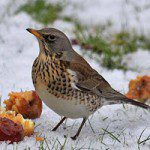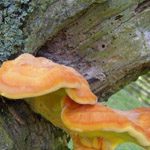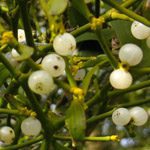By Rebecca Lashley. Listen to the podcast
The boom in orchard planting and fruit production in Worcestershire throughout the 1800s and into the early 1900s was fuelled by the industrial growth of Birmingham, Bristol, London, Manchester and South Wales and the rapid expansion of the country’s railway network, allowing fresh fruit to be transported on a daily basis to the produce markets of the cities. Although the number of England’s orchards has declined dramatically since the war – by up to 85% – Worcestershire still contains around 2000 hectares of orchard, about 6% of the national resource.
Vital reservoirs of biodiverse habitat
The mechanisation of agriculture brought a significant change to the way in which top fruit is produced commercially in the UK. Labour-intensive traditional orchards, with trees grown on tall, standard rootstocks, were replaced with densely-planted bush orchards better suited to management by machine rather than man, contributing to huge social and economic change within our rural landscape. Chemical application became the norm for controlling pests and diseases and traditional grazing and hay cutting of the orchard floor was replaced by mowing or spraying of herbicide.
Most of our remaining traditional orchards are now considerably neglected and derelict. However, far from serving no modern purpose these orchards are now recognised nationally as vital reservoirs of biodiverse habitat within an otherwise often intensively farmed landscape. Their history of organic management, abundance of dead or decaying timber and close association with other habitats such as species-rich grassland, hedgerows and ponds makes old traditional orchards hugely important sites for a number of wildlife species.
There are several thousand varieties of top fruit known from English orchards
Old orchards also contain a significant genetic resource. Contrary to what the supermarket shelves might lead you to believe, there are several thousand varieties of top fruit known from English orchards. Worcestershire itself lays claim to first introducing and commercially marketing 25 different varieties of apple and 4 varieties of plum (see www.worcestershireorchards.co.uk).
From the beginning of the 19th century extensive fruit nurseries developed, including around the outskirts of the city of Worcester, particularly St John’s. One famous St John’s nurseryman, Richard Smith, presided over orchards and glasshouses covering 157 acres. The Smith family business survived for almost 200 years, until the last parcel of land was sold for housing development in 1993. The breeding and introduction of new varieties to the market was a source of pride and competitiveness amongst the various nurseries.
Today, remnants of these once-extensive orchards can be discovered dotted about the city (and wider county) in parks and back gardens.
There is an increasing demand for locally distinctive and locally sourced produce
There is currently a slow but steady and gratifying revival of interest in the fortunes of Worcestershire’s old orchards, with more owners coming forward wanting to restore and replant sites and an increasing demand for locally distinctive and locally sourced produce. Traditionally managed orchards can serve a niche market for artisan ciders and perries, jams, juices and chutneys. They can also provide inspiration for community events and activities, bringing people together to celebrate and help care for this part of our heritage.
Orchards are a habitat that easily crosses urban-rural boundaries, bringing a slice of the countryside and food production into towns and cities. There are plenty of opportunities in Worcester and beyond for getting involved in community-based orchard projects.
The work of Transition Worcester (www.transitionworcester.org.uk) and the Worcestershire Community Land Co-operative (www.wclcoop.org) would be good places to start.
Much of the UK’s mistletoe is concentrated around the west and south midlands
In 2010 traditional orchards were added to the UK list of priority habitats for conservation. In Worcestershire, several plant and animal species associated with orchards are of particular importance because our county contains significant populations of them. For example, much of the UK’s mistletoe is concentrated around the west and south midlands. Mistletoe is not strictly an orchard species in its own right but its favoured host tree, the domestic apple, is. The known distribution of the rare Mistletoe Marble Moth, whose larvae feed on mistletoe producing distinctive leaf mines, is also centred on Worcestershire and surrounding counties.
The Worcestershire Biological Records Centre (http://wbrc.org.uk/) is currently running a project to encourage people to get involved in conserving orchard wildlife, either by locating and checking the condition of old traditional orchards or by taking part in training to identify rare species, like Mistletoe Marble Moth or the Noble Chafer Beetle, another nationally scarce insect with a population stronghold in Worcestershire.









Interested in volunteering?
Those interested in volunteering, and adding some habitat and species survey skills to their CV, can find out more by contacting WBRC on 01905 759759 or orchards@wbrc.org.uk.
Rebecca Lashley is the Environmental Projects Officer for Worcestershire County Council.
Lunchtime Talk – Wednesday 2nd October – everyone welcome
Rebecca will be giving a lunchtime talk at the university on Wednesday 2nd October entitled – the ecology and wildlife of traditional orchards in Worcestershire. Rebecca will tell us about the work the County Council is doing to promote these ancient and valuable habitats.
When: Wednesday 2nd October
Where: EE G131, St. John’s Campus
What Time: 1.15- 2.00
Everyone is welcome.
Dear Rebecca
My parents /grandparents were farming folk ;grandmother from Fyfe in Scotland and settled in south Northamptonshire pre WW1 and planted a small orchard next to their cottage not sure when probably 40s early 50s as cottage is dated 1952 ;now orchard rather sad in terms of recent fallen trees several of these still growing but horizontally once fallen !.
I am not sure how to improve it without ruining certain aspects .
There are some gorgeous apples there including cooking apples and a few exceedingly tasty eating apples .mixed orchard with plums and few pears.
Biodiversity is huge as there are so many insects ; including a lot of the ones that nestle inside the apples !; woodpeckers; badgers; fungi /puffballs; badgers .
I am going to have to put new fences in to keep the sheep in and do ”improvements ” ; new planting /pruning .Its only small but can you steer me to any routes to help ?
I work in a different line so not much knowledge of apples orchards etc
I am not able to visit Worcestershire ; but will listen to your pod cast .
Any advise re info sources to visit / grants ?
Many thanks
Liz
[…] Link to Rebecca’s article: Traditional Orchards of Worcestershire or listen to the talk: […]
So is there a tension between the wildlife value of an old orchard and reviving it by re-introducing orchard management? Presumably such management would involve removing dead wood and diseased branches that support mistletoe, fungi and beetles?
Hi John. There is definitely an important message to be got across that being too tidy in an old orchard will likely be to the detriment of wildlife present there. It’s important to leave as much dead and decaying wood as possible within the orchard – preferably intact and standing upright to keep it as dry and warm as possible. If an orchard has reached such an age as to be really important for wildlife it’s most unlikely you will be able to restore it back to commercial viability, so it’s better to accept it for what it is – an old orchard past the end of its productive life – and manage the ongoing and gentle decline of the trees so as to maximise the benefits to any biodiversity present!
A really fascinating talk from Rebecca on the history of our orchards. The map of the railway system pre Beeching showed graphically how important the instrstucture was to ensuring fruit could reach the urban centres in time for the markets in Manchester and London etc. A great start to the lecture series this year. It was standing room only may need to book a bigger room.